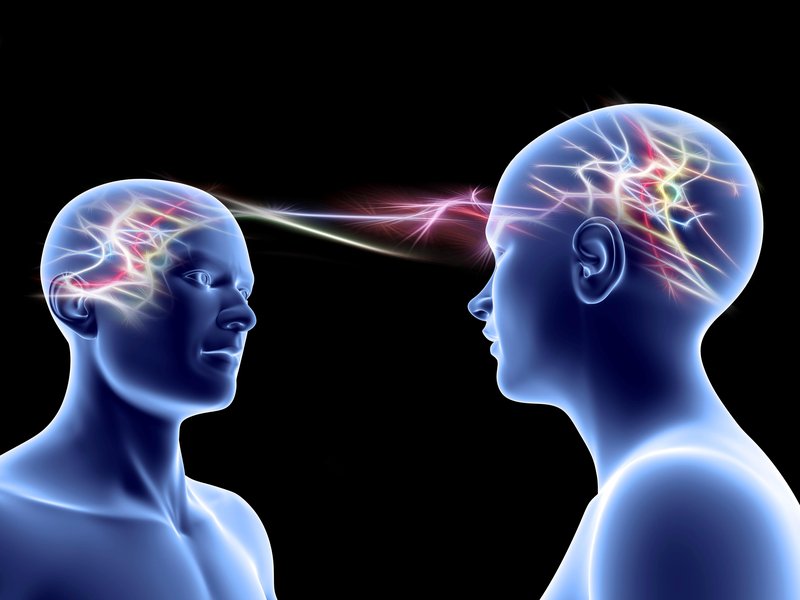Beyond Telepathy
 by Andrija Puharich
by Andrija Puharich
Man has been exploring his mind since time began, and out of it has come all that we know. When the mind becomes uncertain of what it finds, or thinks it knows, then it turns to the outer world and utilizes observation and experiment as a check upon itself. And this is a necessary precaution because a mind unchecked by facts can get out of control and create fantasies that can become injurious to one’s existence, or to others. In this work I give you the stories of normal men and women who have explored the far reaches of their minds, and who were sure enough of their findings to check them against the facts, and be checked by outside observers. What they experienced are examples of telepathy, clairvoyance, the action of mind at a distance, and most remarkable of all — the personality freeing itself of the body and traveling where it will across the reaches of time and space. The following are just two examples.
In the late afternoon of June 14, 1955, Jack Sullivan was alone in a fourteen foot trench welding new thirty-six inch water pipes alongside busy Washington Street in the southwest section of Boston. By 4:30 P.M., the last pipe for the day had been laid in place by the power-shovel crew, who then stopped work, leaving Sullivan to finish welding the seam between the last two pipes in the trench.
Sullivan pulled the welding shield back down over his face and was about to resume welding when the calamity happened. There was no noise, no rumble-no warning-as tons of earth, clay and stone fell upon him from behind. The trench had caved in.
He was knocked down against the pipe in a more or less kneeling position. His legs were doubled up under him, his head was knocked against the pipe, his nose was smashed against the inside of the welding mask. At first he was conscious only of the searing pain in his right shoulder, which was jammed against the red hot weld he had been making on the pipes. He tried to edge away from the hot pipe, but the burden of earth on top of him held him tight against it. He managed to work his left hand up along his body to the shoulder and, wiggling his fingers, tried to get some of the dirt to fall down between the pipe and his burning shoulder. This maneuver was futile, he only burned his hand badly.
Though buried under the earth, he shouted for help, hoping the children might still be around and hear. But after a few shouts he became short of breath. He thought it best to take things easily and not use up the air around the mask too quickly. With the generator running on the truck, probably no one could hear him anyhow, he realized.
Then a vivid picture of Tommy Whittaker came into his mind. Whittaker was his best friend–a welder too, who had been working for Sullivan’s welding company this spring. Whittaker, he knew, was working that day on another part of the water-main project some four or five miles away, near Route 128 in Westwood. Somehow Sullivan got the idea that Tommy Whittaker might help him.
Whittaker didn’t even know that Sullivan was at the Washington Street job. Sullivan had planned to spend the day working in Chelsea, north of Boston. Nobody had worked on the Washington Street job for several weeks. The project there had been held up when the trench-cutting crews had run into rock ledges. Sullivan himself had not been informed of resumption of the pipe-laying there until noon that day. So he knew Whittaker would think he was up north still in Chelsea. But still, Sullivan had a very clear mental picture of his friend working near the golf course in Westwood a few miles away.
Here we must make a brief digression. A physiologist, the late Walter B. Cannon, has made us aware that the emotional condition of extreme danger, or a tendency to flight or fight, is associated with a massive action of the sympathetic nervous system. The sympathetic nervous system in general acts as an antagonist in the body to the parasympathetic nervous system. What one does, the other counteracts. For example, the parasympathetic inhibits or slows down the heartbeat. The sympathetic, on the other hand, accelerates the heartbeat. Sympathetic action prepares the body for great exertion. In general the parasympathetic causes blood vessels to dilate and relax, whereas the sympathetic causes them to constrict. One exception to this rule is in the case of the coronary vessels, where the parasympathetic causes constriction and the sympathetic causes dilatation. The parasympathetic causes the muscles of the pupil of the eye to constrict, and the sympathetic causes the pupil to dilate. In general the parasympathetic causes most of the sweat and salivary and gastric glands to secrete juices, whereas the sympathetic in general causes inhibition of such secretions. In general the parasympathetic, as we have noted, causes marked contraction or increased tone and motility of the gastrointestinal tract. The sympathetic on the other hand causes an inhibition of such motion.
The sympathetic nervous system is activated by adrenalin and related adrenalin-like compounds. Therefore, dominance of the sympathetic nervous system is called adrenergia. The parasympathetic system on the other hand acts on the effector cells, that is, muscle and gland cells, by liberating acetylcholine, and its dominance is called the cholinergic system. When Sullivan was buried under the earth, he obviously suffered all the sense of great danger, at the same time suffered great pain because of the severe burn to his right shoulder. These two conditions plus his determination to fight his way out of this could only result in a massive activation of the sympathetic nervous system. In short, he was chemically under the domination of adrenergia. Let’s see what happened to him.
Farther south in Boston, in Westwood, Whittaker was welding more water pipes. Working with him was Danny, a welder from another company. They were welding overtime in order to finish up a seam before stopping for the night.
Welding becomes an automatic job (Whittaker later told us), so that all sorts of irrelevant things run through your mind and you hardly know you are working. Into Whittaker’s mind, as he worked that afternoon, came the idea that he ought to go up to Washington Street and check. It was so vague that he can hardly explain it. He felt that something was wrong. No particular person came to mind, only the persistent idea that he should go and check.
We here note that Whittaker is in an ideal condition for what we have earlier described for the receiver in telepathy. In the first place, he was working physically on a hot day. This activation of the skeletal muscle system alone is sufficient to induce a mild state of cholinergia. Secondly, because of the routine and monotony of his work, he was able to drift into a daydreaming, relaxed state of mind. This again is a good condition for telepathic reception.
Whittaker got up and started to pack up his equipment.
“Where are you going?” asked Danny.
“I’m going up to the Washington Street job,” answered Whittaker.
“There’s nobody working up there now, is there?” said Danny.
“No, but I think I’d better go.”
“But we’ll finish up here in half an hour,” Danny pointed out.
“Well, I think I’d better go now. There might be something wrong.”
So he drove off, leaving Danny alone to finish up. It was about 5:30 P.M.
Usually when he quit work there, he went straight on to Route 128, the super-highway around Boston, and on home to Stoneham in the north. This night, he turned back into the heavy traffic and drove to Washington Street. He still doesn’t know exactly why he did it—something seemed to be drawing him on.
Nearing the trenches on Washington Street (near De Soto Road), he saw one of his company’s trucks standing there with the generator running. He drew up behind it. No one was around. He got out and walked over to the trench. At first all he saw was dirt. Then he realized there had been a cave-in. Finally he saw the hand sticking out.
Sullivan says, “When Tommy jumped into that hole, I felt the earth shake and knew that help had come. Thank God.”
It was 6:30 P.M. when he was lifted out. Whittaker had made the discovery about 6, so his friend must have been buried over an hour.
This case clearly shows that the sender in this telepathic interaction was Sullivan. Sullivan was under great stress and as described earlier, had a massive adrenergia. Whittaker, as the receiver in the telepathic interaction, was probably in a mild state of cholinergia, very relaxed, and therefore most receptive for receiving a telepathic impression. The fact that Whittaker went back into the city during the heavy traffic hour against his usual routine, is proof enough that he was guided by some telepathic urge, unformed though it was.
There is another case which brings out certain aspects of the role of the sender in a different way. John Hayes was a second-year student at San Jose State College in California. He was engaged in a fraternity hazing party. This occurred on a Saturday. It was John’s mission to take a group of freshmen up into the High Sierras where spring snow conditions still prevailed. The distance to the Sierras was about 150 miles and John left sometime after midnight on this wild journey. He was in the mountains driving fast and rather recklessly when suddenly in the car lights there appeared a gaping hole in the road ahead. The car plunged down a seventy-five-foot embankment. John was terror-stricken as the car plunged off into the dark unknown. Miraculously the car landed right side up and after plunging ahead about two hundred yards through the brush and undergrowth came to a safe stop. No one was injured in this accident.
In the meantime John’s mother and father were asleep in Salinas, California, about 180 miles away from the scene of the accident. John’s mother awakened abruptly from a deep sleep and across her mind there flashed a vision of her son being in an automobile accident. She looked at the clock, it was exactly 5:30 A.M. She had no idea where her son was or why he should be in an auto accident at this hour. She awakened her husband, who simply grunted something about ”women and their premonitions” and went back to sleep. Mrs. Hayes, however, was so sure of her vision that she arose and placed a telephone call to the college. No one at the college could tell her where her son was. As a matter of fact, it was about twelve hours before her son was able to reach a phone and telephone her. One of the first things that Mrs. Hayes said to her son when she heard his voice was, “Did you have an accident? Are you well?” Her son replied that he was well, but how did she know that he had had an accident? Then she related to him her experience. He confirmed then and there that it was about 5:30 in the morning when his car had plunged down into the washout.
The son obviously experienced a sudden adrenergia as his car plunged over the washout. His mother on the other hand was asleep and relaxed. John had no thought, as near as he can recollect, as he plunged down the washout, of thinking at all of his mother or family. The mother’s mind on the other hand reached out and projected to the scene and it seems that she saw only the relevant portion of the scene: she knew her son was involved in an auto accident. She had no idea where it was or the fact that he was plunging down a washout. Here we have an ideal illustration of the adrenergic state of the sender, and the relaxed cholinergic condition of the receiver, the mother.
Crisis cases like this impressed me forcibly as I observed telepathic senders in the laboratory. I was well aware that in general a telepathic sender made a determined effort to concentrate during tests. The receiver on the other hand generally tried to remain relaxed and stated the first thing that entered his blank mind. I tried in a number of ways to induce an artificial state of adrenergia and pinpoint concentration in senders. I must say that most of these attempts were unsuccessful. It is very difficult to artificially bring on a true crisis adrenergia based on a feeling of flight, fright, or fight.
However, the opportunity eventually arose to test this notion. While working with Peter Hurkos I observed that he seemed to have an abnormal fear of electricity. I knew that Hurkos, as a telepathic sender working with Harry Stone under normal room conditions, could achieve an average score of about twelve hits out of fifty ESP-test trials. This is barely significant for telepathy in one run. I therefore planned an experiment in which he, as the sender, was supposed to sit on a foot plate which had a ten-thousand-volt direct current charge on it. Actually the nature of the charge was such that even though he was sitting on the foot plate and the electricity was turned on, he would not experience any shock. I explained this carefully to Peter and assured him that he would not in any way be hurt. He was enterprising enough to go ahead with the experiment, but I could see grave doubts and fears written all over his face as the experiment began. The experiment was extraordinarily successful. The average score jumped from the twelve correct hits out of fifty to thirty-one correct hits out of fifty trials. This is overwhelming evidence of telepathic interaction. There was no doubt that Hurkos’ fear was profound as he sat on the electrically charged foot plate. I repeated these experiments seven times with the same results.
In repeating the same test with other sender subjects I found that the results were variable. Some subjects got higher scores when they were thrown into an artificial state of fear by being on an electrically charged plate, and others got lower scores. In general this seemed to correspond with the individual’s psychological reaction to electricity. For example, I know of some people who love to see lightning. It gives them great elation and joy to watch this awesome display of nature. Others are terrified by a flash of lightning and by the rumble of thunder. In general I was never able to create under laboratory conditions a consistent situation which would maintain sustained adrenergia in different senders during a telepathic test.
The basic act of sending in telepathy appears to be psychologically a centripetal one, concentration. In fact, the word sender in telepathy is a misnomer in that the sender does not send anything out, but rather serves as a center of attraction drawing to him the attention of the receiver. It is as though the sender creates a mental vacuum toward which the receiver’s mind is drawn. The sender by his need and desire prepares a mental stage; the receiver in turn populates the stage with his own symbols and images.
Excerpt from Beyond Telepathy
See full pdf download here.
Posted in ESP, Other Topicswith comments disabled.





